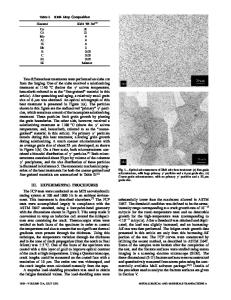Fatigue crack propagation behavior of a single crystalline superalloy
- PDF / 2,032,718 Bytes
- 9 Pages / 594 x 774 pts Page_size
- 65 Downloads / 351 Views
I.
INTRODUCTION
DUE to
increasingly stringent demands on aircraft turbine materials, single crystalline superalloys have achieved great importance. Several studies have reported the creep tl-5] and tensile t~'3'6-81 properties of such materials. Others have been concerned with the low-cycle fatigue performance of single crystals, t3'9-~21However, there has been limited information about the crack propagation behavior of such crystals. [13-16] Therefore, the goal of this investigation was to assess the crack propagation mechanisms occurring at various temperatures in a single crystalline superalloy. II.
EXPERIMENTAL PROCEDURE
Single crystals of the Ni-base alloy RENI~* N4 ob*RENI~ is a trademark of General Electric Company, Fairfield, CT.
tained from the General Electric Company were used. This alloy is typical of new generation single-crystal alloys with a high volume fraction of 3/. Compact tension specimens (Figure 1) were machined from two slabs to give a loading axis parallel to [001] and a [110] direction parallel to the machined notch. Four specimens were machined from each slab. The specimens machined from the A349 slab deviated from the idealized [001] orientation by about 2 +- 2 deg and by 2 - 2 deg from the [110], whereas those taken from the M348 slab deviated by 7 --- 2 deg from the [001] and 12 -+ 2 deg from the [110]. The orientation of the specimens was determined using Laue back reflection techniques. The idealized crystallographic orientation with respect to the crack plane and the position of the {111} slip planes is shown in Figure 2. Specimens were precracked at room temperature (RT) at a frequency of 10 Hz with an R ratio (minimum load/ maximum load) of 0.1. The crack was initiated at AK = 27.5 MPaX/~. The stress intensity was progressively reduced in steps in such a way that AK was never less than 80 pct of the previous AK. Finally, 0.64 mm were
B.A. LERCH, Research Scientist, is with NASA Lewis Research Center, Cleveland, OH 44135. STEPHEN D. ANTOLOVICH, Professor and Director of School of Materials Engineering, is Director of Mechanical Properties Research Laboratory, Georgia Institute of Technology, Atlanta, GA 30332-0245. Manuscript submitted July 17, 1989. METALLURGICAL TRANSACTIONS A
grown under a A K = 17.6 MPak/m to provide a common starting point. This resulted in a final precrack length, excluding the machined notch, of approximately 2.5 mm. This process was rapid and provided a final AK (and plastic zone size, Rp) at which the actual test could commence without causing crack growth retardation or acceleration. The initial crack length, a0, was taken as the mean of the precrack lengths as measured on both specimen faces. After precracking, testing was done in air according to ASTM E647 standards, t17] One specimen was tested at RT. The others were heated to the test temperature and maintained at that temperature for a total of 2 hours before testing to ensure thermal equilibrium. A clamshell resistance furnace was used to attain test temperatures of 704 ~ 927 ~ 1038 ~ and 109
Data Loading...











